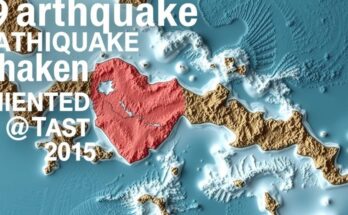Tens of thousands protested in Iranian cities and Sanaa, Yemen, against Israeli attacks on Lebanon and Gaza, responding to government calls for support of Hezbollah. Demonstrators condemned Israeli forces while expressing solidarity with Palestinians. These events reflect heightened tensions in the Middle East following Hamas’s attacks and subsequent Israeli retaliations, with Iran navigating a complicated role within the conflict.
On Friday, extensive protests took place across Iran and in the rebel-controlled Yemeni capital, Sanaa, with tens of thousands condemning Israeli military actions in Lebanon and Gaza. These protests were catalyzed by calls from Iranian officials to express solidarity with the Iran-backed group Hezbollah and denounce what they termed as the “barbaric crimes of the Zionist regime in Palestine,” as stated by the official IRNA news agency. Hezbollah, recognized as part of the “axis of resistance,” which includes other Iran-aligned military factions, has engaged in hostilities with Israel and American forces in backing Palestinian militant operations. This alliance also encompasses the Huthi rebels of Yemen, who organized a significant demonstration in Sanaa, occurring just after they reportedly launched a missile towards Israeli territory. In Tehran, following Friday prayers, a substantial gathering was noted around Enghelab Square, where demonstrators carried images of Hassan Nasrallah, the leader of Hezbollah, and waved flags representing both Hezbollah and Palestine. Protesters chanted slogans declaring, “Israel is destroyed. Lebanon is victorious,” simultaneously expressing their disapproval of what they described as a “bloodbath in Lebanon” by incinerating Israeli and U.S. flags. Coverage of similar protests was broadcasted by state media from various cities including Semnan, Qom, and Shiraz. In Sanaa, a large assembly of protesters, some armed, voiced their support for Lebanon, with statements emphasizing their endurance alongside Palestinians against Israel. A Huthi supporter, Mortada al-Mutawkil, remarked, “We say to our brothers in Lebanon that you will be victorious, God willing.” Additionally, Mohammed Mushki, another demonstrator, declared, “No matter how long the war lasts and no matter how big it is, we are on their side, all the Yemeni people, on the side of the Lebanese and Palestinian people until victory, God willing.” Contrastingly, in Bahrain, an Israeli ally that suppresses protests, two separate demonstrations took place condemning the violence in Gaza and Lebanon. Hundreds rallied in a northern village against the Israeli attacks, showcasing solidarity with those in Gaza and Lebanon, while protesters in the capital called for the cessation of diplomatic relations with Israel, chanting, “The people demand an end to normalization.” The current wave of violence has escalated following Hamas’s assault on Israel on October 7, which prompted a military response from Israel and increased attacks from Hezbollah. The recent escalation has resulted in significant casualties and destruction, the deadliest since the Lebanese civil war from 1975 to 1990. Observers note that Iran is navigating a precarious situation, endeavoring to support Hezbollah while avoiding the potential pitfalls of a broader conflict that could enhance the position of adversaries.
The ongoing tensions in the Middle East, stemming from the long-standing hostilities between Israeli forces and various militant groups, have recently intensified, particularly after Hamas launched an assault on Israel that prompted retaliatory actions. As a key ally of various militant factions in the region, Iran influences numerous groups, including Hezbollah in Lebanon and the Huthis in Yemen, which actively engage against Israel, promoting their interests under the banner of resistance. These developments coincide with protests reflecting regional unrest and solidarity with Palestinians, highlighting the complex geopolitical dynamics and affiliations among Middle Eastern countries in the aftermath of escalating violence.
In conclusion, the protests in Iran and Yemen highlight a significant display of solidarity with Hezbollah and the Palestinian people in response to the perceived aggression of Israel. As the violence continues to escalate, the nature of these demonstrations underscores the interconnectedness of armed groups in the region and the broader implications for regional stability. The concerted calls for resistance against Israel signify ongoing tensions that have deep historical roots, and Iran’s critical balancing act amidst these dynamics remains crucial for future developments in the region.
Original Source: www.france24.com




